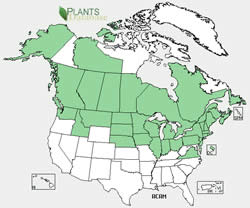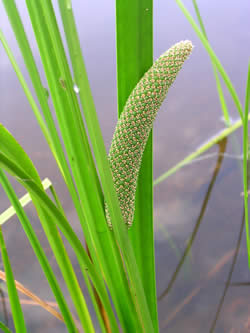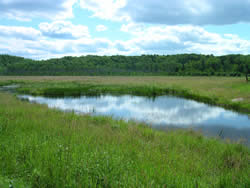Plant of the Week
 Acorus americanus range map. USDA PLANTS Database.
Acorus americanus range map. USDA PLANTS Database.
Sweet Flag (Acorus americanus (Raf.) Raf.)
By Brandee Wenzel
At first glance, a colony of Sweet Flag may resemble cattail (Typha spp.) or Blue Flag Iris (Iris versicolor); however, its bright green, sword-shaped leaves bearing a greenish-yellow, finger-like structure set it apart from all others. Most notably, Sweet Flag is easily distinguished by the pleasant fragrance given off when the leaves are broken. Sweet flag is of ancient stock - DNA evidence supports Acorus as the oldest surviving line of monocots, perhaps providing paleontologists with a picture of the past.
Its preferred habitat is mucky shorelines and shallows, often making its home in up to a foot of water. The flowering structure is a spadix, similar to that of a jack-in-the-pulpit. However, the sweet flag spadix is surrounded not by a spathe but rather the distal portion of a sympodial leaf. This information incidentally supported the removal of Acorus from the arum family (Araceae) and placement into its own family, the sweet flag family (Acoraceae).
Taxonomically speaking, Acorus has caused much confusion in North America. Recent work has documented the existence of two separate species, A. calamus, and A. americanus. The former is an introduced sterile triploid, while the latter is a native fertile diploid. Interestingly, the distribution of Native American tribes reported to use Acorus corresponds to the range of the native species. Sweet flag is found across southern Canada, in the Northeast and upper Midwest.
It is likely that Native Americans played a significant role in the distribution of Sweet Flag, as it was used in ceremonies, medicines, and for trade. Disjunct populations have been noted to occur in areas that are often near old village sites and camping areas.



